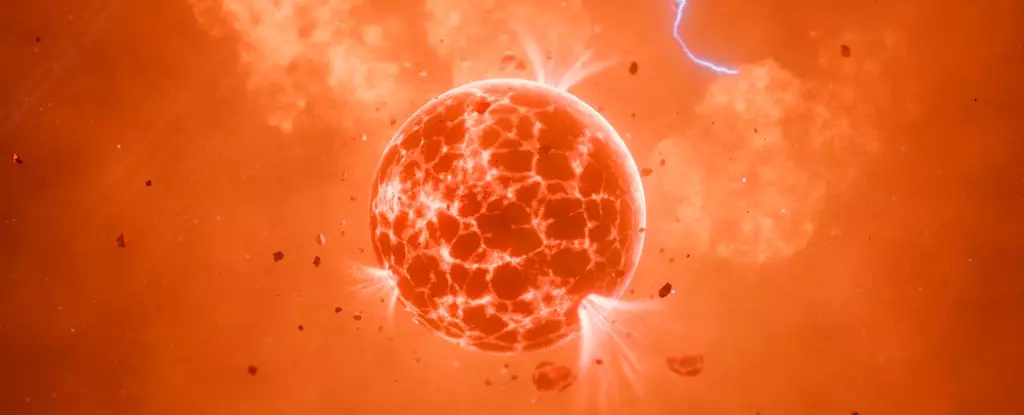Recent astronomical research has unveiled compelling evidence suggesting the existence of an extraordinarily volcanic moon orbiting the gas giant exoplanet WASP-49b, situated approximately 635 light-years away from Earth. This discovery provides insight into the processes that govern moon formation and activity in distant solar systems. As scientists delve deeper into the characteristics of this exomoon, it could reshape our understanding of planetary systems beyond our own, revealing a dynamic interplay between gas giants and their moons.
Central to this remarkable finding is a significant cloud of neutral sodium that has been detected in the vicinity of WASP-49b, signaling eruptive volcanic activity on its hypothesized exomoon. Notably, the sodium cloud exhibits peculiar characteristics, such as an orbit that deviates from what one would typically expect of a gas giant’s atmosphere. According to Apurva Oza, an astrophysicist at the California Institute of Technology, the sodium signature is a pivotal indication that its source may not originate from the planet itself but rather from a volcanic moon that actively releases material into space.
For a gas giant like WASP-49b, the notion of volcanic activity challenges traditional astrophysical paradigms. Gas giants, composed primarily of hydrogen and helium, do not possess the geological structures conducive to volcanism. This factor raises significant intrigue: how can a moon within such a system exhibit violent geological activity? The peculiar trajectory of the sodium cloud may reflect a volcanic exomoon moving in a manner inconsistent with the orbital patterns we typically associate with gas giants.
Understanding the prevalence of moons in the Milky Way galaxy calls for a closer examination of existing celestial neighbors. In our Solar System, moons significantly outnumber the planets, with nearly 300 recognized against a backdrop of eight primary bodies. Yet, the hunt for exomoons has proven challenging. While exoplanet detection methods have evolved, the identification of moons has been notably elusive. Initial findings often focus on more dominant signals from planets, sidelining subtler indications of satellite activity.
In 2017, the initial discovery concerning WASP-49b’s atmosphere revealed an unexpected layer of sodium at unusually high altitudes. Following this revelation, Oza and colleagues proposed that the sodium could not have arisen from the exoplanet itself, leading to their hypothesis of an active exomoon. The findings from 2019 suggested that this moon bears striking resemblance to Jupiter’s highly volcanic moon, Io, known for its extreme surface activity.
To solidify their claims, Oza’s team conducted further observations using the European Southern Observatory’s Very Large Telescope over four consecutive nights. This method marked a systematic approach, allowing the researchers to monitor the sodium cloud’s dynamics in greater detail. Their observations revealed that the sodium presence fluctuated, sometimes disappearing behind the star or the exoplanet, indicating a transitory pattern of volcanic activity rather than a steady-state phenomenon.
This variability suggests that the sodium cloud’s generation is a continuous process, creating a constant discharge of gases and materials. This phenomenon aligns with what scientists observe on Io, where intense volcanic eruptions release material into space, impacting the surrounding areas of the planet it orbits.
The implications of this discovery extend beyond mere observations; they pose questions about the fate of the volcanic exomoon itself. Oza’s analysis indicates that, closely bound to WASP-49b, this moon experiences gravitational influences akin to those felt by Io, affected by other nearby moons, which could hasten its eventual demise. The moon could fall victim to an unstable orbit caused by its own volcanic activity and the gravitational pull of its massive planetary companion, leading to a destructive end that would erase evidence of its previously volcanic existence.
The discovery of a volcanic exomoon orbiting WASP-49b is a significant stride in exoplanetary science, redefining our understanding of celestial dynamics and planetary evolution. It highlights the potential for complex geophysical processes occurring in distant worlds, challenging preconceptions about gas giants and their satellite systems. As technology advances and observational techniques improve, astronomers are poised to unveil further extraordinary characteristics of exoplanets and their moons, promising to expand our knowledge of the universe and our place within it. The narrative surrounding exomoons is not only a testament to scientific inquiry but also an awakening to the vast mysteries lying within the cosmos, waiting to be explored.


Leave a Reply